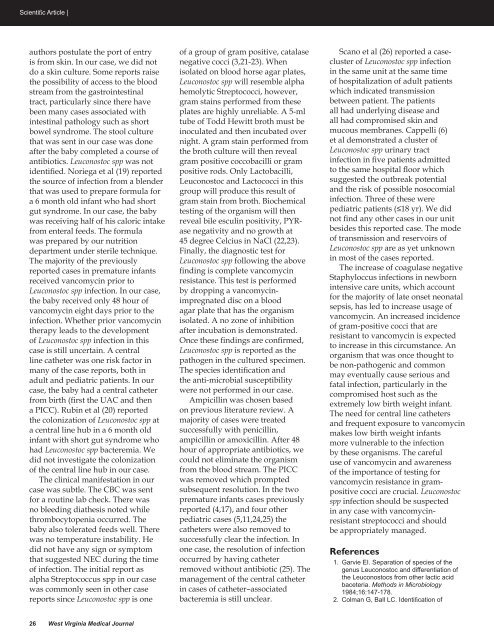September/October - West Virginia State Medical Association
September/October - West Virginia State Medical Association
September/October - West Virginia State Medical Association
- No tags were found...
You also want an ePaper? Increase the reach of your titles
YUMPU automatically turns print PDFs into web optimized ePapers that Google loves.
Scientifi c Article |authors postulate the port of entryis from skin. In our case, we did notdo a skin culture. Some reports raisethe possibility of access to the bloodstream from the gastrointestinaltract, particularly since there havebeen many cases associated withintestinal pathology such as shortbowel syndrome. The stool culturethat was sent in our case was doneafter the baby completed a course ofantibiotics. Leuconostoc spp was notidentified. Noriega et al (19) reportedthe source of infection from a blenderthat was used to prepare formula fora 6 month old infant who had shortgut syndrome. In our case, the babywas receiving half of his caloric intakefrom enteral feeds. The formulawas prepared by our nutritiondepartment under sterile technique.The majority of the previouslyreported cases in premature infantsreceived vancomycin prior toLeuconostoc spp infection. In our case,the baby received only 48 hour ofvancomycin eight days prior to theinfection. Whether prior vancomycintherapy leads to the developmentof Leuconostoc spp infection in thiscase is still uncertain. A centralline catheter was one risk factor inmany of the case reports, both inadult and pediatric patients. In ourcase, the baby had a central catheterfrom birth (first the UAC and thena PICC). Rubin et al (20) reportedthe colonization of Leuconostoc spp ata central line hub in a 6 month oldinfant with short gut syndrome whohad Leuconostoc spp bacteremia. Wedid not investigate the colonizationof the central line hub in our case.The clinical manifestation in ourcase was subtle. The CBC was sentfor a routine lab check. There wasno bleeding diathesis noted whilethrombocytopenia occurred. Thebaby also tolerated feeds well. Therewas no temperature instability. Hedid not have any sign or symptomthat suggested NEC during the timeof infection. The initial report asalpha Streptococcus spp in our casewas commonly seen in other casereports since Leuconostoc spp is oneof a group of gram positive, catalasenegative cocci (3,21-23). Whenisolated on blood horse agar plates,Leuconostoc spp will resemble alphahemolytic Streptococci, however,gram stains performed from theseplates are highly unreliable. A 5-mltube of Todd Hewitt broth must beinoculated and then incubated overnight. A gram stain performed fromthe broth culture will then revealgram positive coccobacilli or grampositive rods. Only Lactobacilli,Leuconostoc and Lactococci in thisgroup will produce this result ofgram stain from broth. Biochemicaltesting of the organism will thenreveal bile esculin positivity, PYRasenegativity and no growth at45 degree Celcius in NaCl (22,23).Finally, the diagnostic test forLeuconostoc spp following the abovefinding is complete vancomycinresistance. This test is performedby dropping a vancomycinimpregnateddisc on a bloodagar plate that has the organismisolated. A no zone of inhibitionafter incubation is demonstrated.Once these findings are confirmed,Leuconostoc spp is reported as thepathogen in the cultured specimen.The species identification andthe anti-microbial susceptibilitywere not performed in our case.Ampicillin was chosen basedon previous literature review. Amajority of cases were treatedsuccessfully with penicillin,ampicillin or amoxicillin. After 48hour of appropriate antibiotics, wecould not eliminate the organismfrom the blood stream. The PICCwas removed which promptedsubsequent resolution. In the twopremature infants cases previouslyreported (4,17), and four otherpediatric cases (5,11,24,25) thecatheters were also removed tosuccessfully clear the infection. Inone case, the resolution of infectionoccurred by having catheterremoved without antibiotic (25). Themanagement of the central catheterin cases of catheter–associatedbacteremia is still unclear.Scano et al (26) reported a caseclusterof Leuconostoc spp infectionin the same unit at the same timeof hospitalization of adult patientswhich indicated transmissionbetween patient. The patientsall had underlying disease andall had compromised skin andmucous membranes. Cappelli (6)et al demonstrated a cluster ofLeuconostoc spp urinary tractinfection in five patients admittedto the same hospital floor whichsuggested the outbreak potentialand the risk of possible nosocomialinfection. Three of these werepediatric patients (≤18 yr). We didnot find any other cases in our unitbesides this reported case. The modeof transmission and reservoirs ofLeuconostoc spp are as yet unknownin most of the cases reported.The increase of coagulase negativeStaphyloccus infections in newbornintensive care units, which accountfor the majority of late onset neonatalsepsis, has led to increase usage ofvancomycin. An increased incidenceof gram-positive cocci that areresistant to vancomycin is expectedto increase in this circumstance. Anorganism that was once thought tobe non-pathogenic and commonmay eventually cause serious andfatal infection, particularly in thecompromised host such as theextremely low birth weight infant.The need for central line cathetersand frequent exposure to vancomycinmakes low birth weight infantsmore vulnerable to the infectionby these organisms. The carefuluse of vancomycin and awarenessof the importance of testing forvancomycin resistance in grampositivecocci are crucial. Leuconostocspp infection should be suspectedin any case with vancomycinresistantstreptococci and shouldbe appropriately managed.References1. Garvie EI. Separation of species of thegenus Leuconostoc and differentiation ofthe Leuconostocs from other lactic acidbaceteria. Methods in Microbiology1984;16:147-178.2. Colman G, Ball LC. Identifi cation of26 <strong>West</strong> <strong>Virginia</strong> <strong>Medical</strong> Journal















